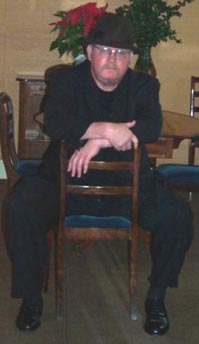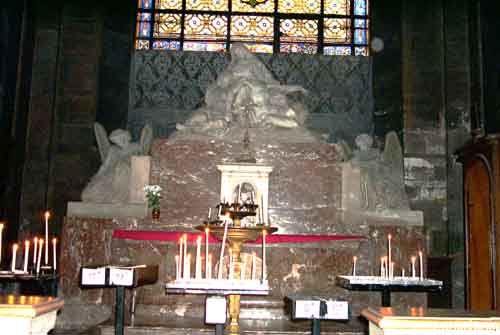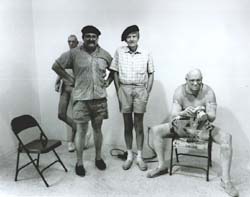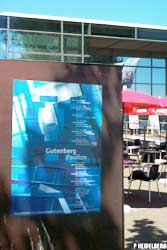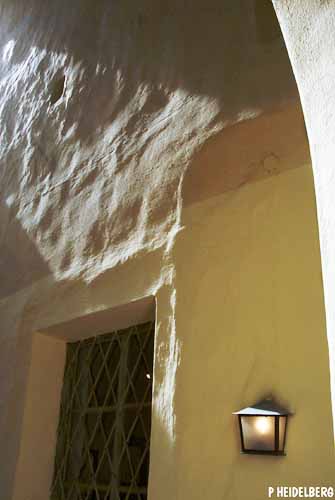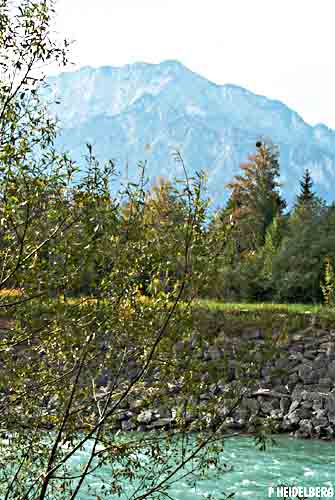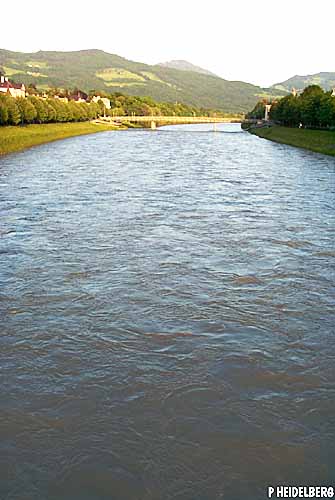Paris, Prague and Salzburg:
A Remembrance
BY PAUL HEIDELBERG
(Copyright,
U.S. Library of Congress)
I WRITE IN MEMORY OF LOVED ONES,
INCLUDING HODIE, MY GREAT FRIEND OF MANY YEARS, OF MY FATHER JAMES MARTIN
HEIDELBERG, OF MY GOOD FRIEND DUANE HANSON, OF LOVED ONES OF LOVED ONES,
SUCH AS PATRICIA MERCER AND MICHAEL MERCER, AND OF W.A. MOZART, A GREAT
FRIEND WHOSE COMPANY I HAVE ENJOYED SINCE CHILDHOOD: MOZART IS BEAUTY,
BEAUTY IS MOZART.
PREFACE
SAN ANTONIO
DAD, THE YEAR AFTER
YOU DIED, I MADE MY FIRST TRIP TO HEIDELBERG, AND TOASTED YOU DAYS LATER
AT THE MATHASIER BIER STADT IN MUNICH, AS I MIGHT HAVE RAISED A GLASS TO
YOU IN HOUSTON AT THE CHAMPIONS GOLF CLUB LOCKERROOM, OR AT THE CHAMPIONS
BALLROOM, "WALTZ ACROSS TEXAS" IN THE BACKGROUND.
SITTING UNDER
THIS TREE ON THIS BENCH, I TOAST YOU NOW, AND WILL TOAST YOU IN PARIS,
PRAGUE AND SALZBURG, DRINKING A BEER IN YOUR NAME IN EACH, REMEMBERING
YOUR IMMORTAL ATTRIBUTES I CARRY WITH ME STILL: HONESTY, GOOD-NATUREDNESS
AND A SINCERE CONCERN FOR YOUR FELLOW MAN.
ADIEU AND HELLO... APRIL
23, 1999, FORT SAM HOUSTON NATIONAL CEMETERY, SAN ANTONIO,
TEXAS..................
APRIL 23, 1999, 2:24 CST, TERRELL HILLS,
TEXAS, IN A NATUREPARK REMINISCIENT OF FRANCE.
THIS WAS NOT EASY,
HANSON. WRONG TURN AT THE CEMETARY -- NO EXIT.
AS WE WOULD SAY IN
FLORIDA, THE FEELS LIKE TEMPERATURE ON THIS APRIL TEXAS DAY IS ABOUT 105.
I BICYCLED IN THE SUN FOR ABOUT AN HOUR.
THIS IS THE SPOT I VISITED
IN JANUARY, 1996, ABOUT TWO HOURS AFTER I HAD LEARNED YOU HAD
GONE.
THEN, WITH A RADIO HEADSET, I LISTENED TO BACH. NOW WITH THE
SAME HEADSET, SISTER JEANETTE'S, I LISTEN APPROPRIATELY TO STRAUSS; DER
ROSENKAVELIER WAS ONE OF YOUR FAVORITES, YAH?
THEY FINALLY GAVE YOU
A RETRO THREE YEARS AFTER YOUR EXIT. "THE NEW YORK TIMES" GAVE YOUR
WHITNEY MOAA SHOW AN EXCELLENT REVIEW -- ''IN THE FUTURE HIS WORK WILL BE
MUCH MORE DIFFICULT TO DISMISS,'' OR SOME SUCH VERBIAGE.
I COULD
TELL SHE ''GOT'' YOUR WORK.
I WILL HAVE A HALBEN LITER IN SALZBURG
TO YOU, OLD FRIEND, AND RECALL OUR TIMES IN THE JOE GEIGER HOUSE, AND OUR
REGULAR TELEPHONE CONVERSATIONS -- YOU ALWAYS TELLING ME EXCITEDLY ABOUT
THE MOST RECENT ERUDITE WORK YOU WERE READING, SUCH AS A BOOK BY WILL AND
ARIEL DURANT; THESE PEOPLE KNOW NOTHING OF THAT SIDE OF YOU -- I THINK
THEY WOULD BE SURPRISED...THE FARMBOY FROM MINNESOTA WHO MADE IT
BIG...
I WILL BE SURE THE BEER HAS A GOOD HEAD ON IT, MY GOOD
FRIEND, AS YOU ALWAYS DESIRED.
PROSIT UND AUF
WIEDERSHEN...
PARIS.............................................
6:49 AM, April 27, 1999 Rue de Fleurus, Paris 75006
I always have
trouble remembering if it is Rue de Fleurus or Rue des Fleurus; today, as
the first light of day lights my computer through the large French doors
that open onto my black, wrought-iron balcony, I don't have that
problem.
I can look across the street at the blue, green and white
street marker:
6e Arr. Rue de Fleurus
When I first stayed at
this hotel in 1987, Der Wolfhund was four years old. She got that nickname
one night when a German painter friend of mine first saw her. "Oh, you've
got a Wolfhund," he exclaimed, impressed wth her stature.
I should
have said, "What did you think I'd have -- a damned poodle?"
On the
last morning of her life, barely able to stand, ravaged by cancer, she
held up her head proudly next to my bed as I fell apart with
emotion.
I vowed to her then that I would write this work. Three
and a half years later, I am able to write it in a fashion that befits
her. I will tie her story in with the story of W.A. Mozart, in my opinion
one of the world's four greatest composers -- the others being J.S. Bach,
Beethoven and Wagner (Herr Bach's stature has risen lately in my book --
among other things, he was the world's first jazz musician [just listen to
the bass elements in his Mass in B Minor] ).
My room sits about
fifteen feet above the Rue de Fleurus, where Ernest Hemingway regularly
walked on his visits up the street to 27, Rue de Fleurus, to visit
Gertrude Stein.
After admiring Hemingway and his writing nearly all
my life, writing about him in "Sports Illustrated" nearly 15 years ago,
and meeting and interviewing his son Patrick only last year, I am finally
about to exorcise Papa from my Muse/Soul.
"I've got my own damned
writing and black lonelies to deal with," I might say, as he might
say.
I think I got his tone down nearly perfectly in my fiction
work "Ernesto and Jimmy."
Now, I am wanting to be done with him, in
a sense.
But when I read in some poll of chicy chic American
writers that two of his novels are ranked 43rd and 75th on their list of
top 100 American books, I've got to laugh.
And who is Number One?
John Grisham or Tom Wolfe? (The association is well intended, Monsieur
Wolfe; I am sorry).
Hemingway is the best writer America has ever
had; that opinion stands, whether or not I have exorcised
him.
Hemingway had his Black Dog. Hodie was my Brown, Black Dog.
She was constantly by my side as I sweated out my two novels OCEANS APART
and COOK'S RETURN -- metaphorically, and literally in the oppressive
Florida heat, air conditioning or no air conditioning.
With a
Chocolate Labrador mother and a German Short-haired Pointer father, Hodie
had a rare breeding I have not seen in any full-blooded hunds. As I wrote
once before, any derision she might have received because of her
mixed-blood lineage was totally unfounded. Her lineage was far better than
that of most of the people I have met.
This dog had
class.
After one of my four writing trips to France's Charente
Region, home of the world's finest spirit Cognac, I conducted a taste test
with my hund:
I offered her two glasses to smell: one contained a
mundane VSOP from one of the big houses such as Courvoisier or Remy
Martin, and the other held an Extra cognac -- a super-fine cognac that is
rated above even XO cognacs in quality and aging. Hodie turned up her nose
at the VSOP but started lapping up the Extra.
Enough
said.
Hard times have hit Cognac, and France. I noticed last night
that the Boulangerie across the street appeared shut. Nicely dressed
garbagemen, attired in green uniforms to match their green truck, just
carted off some of the store's final offerings: three garbage bags full of
stale baguettes. Paris 7:25 AM April 28, 1999.
(The sounds and
smells here are remarkably familiar. We all get older, but Paris remains
the same age [Paris is the beautiful woman you always return to].
Yesterday, I barely recognized the barman at the Restaurant du Luxembourg
-- his graying beard had turned him into someone else).
Back the
next day with this news: Just as a premature Obit kills someone too soon,
I killed the Boulangerie across the street before its time was up.
Apparently, it was just closed on Monday and Tuesday -- the garbagemen
carting off large bags of stale baguettes must be part of the regular
routine.
There are too many Americans in Paris now -- I hate
hearing English with an American accent being spoken loudly on these
streets; it is sort of like screaming in church, I would
say.
Yesterday I visited Eglise St. Sulpice for the first time this
trip. I suppose I would call it "My Church." It has an ambience that is
quite appropriate for artistes et ecrivains, which is why Hemingway,
Fitzgerald and Faulkner each attended services there I read somewhere (I
am surprised they each attended services anywhere).
Every time I
have visited the church, I have seen at least two artists
sketching.
Patricia Mercer and Michael Mercer, whom I mentioned
earlier in dedication, were the mother and brother of mon ami Frances
Mercer. I have known Francie since January, 1972, when I met her in a
orientation class at the San Franciso Art Institute, the best art school
in the United States (when I first visited the Ecole des Beaux Arts in
Paris, the similarity of the two art centers was remarkable). We both are
graduates of the SFAI.
Back in those days, I was a painter and a
poet, reading regularly at such North Beach venues as the Coffee Gallery
with my good friend poet Wilfredo Castano, a Vietnam Veteran Marine who
wrote beautiful, firey verse that reminded me of Federico Garcia Lorca
(now I would call myself a writer, I suppose, although I do still take
photographs and paint).
Francie is a very good artist and a very
good person (and I think it is significant for both of us that I put
artist first -- although when rereading this that seems to imply she is
lesser of a very good person, which is not the intention of the ranking).
She was doing fine representational and abstract paintings when I met her
and recently has been working on a superb series of watercolors of verdant
Florida scenes that combine elements of the representational and the
abstract.
Hodie slept on Francie's neck as a puppy and I e-mailed
Francie recently that losing Hodie was like losing a child.
I was
with Hodie when she was born, during a 12-hour labor she and her three
siblings and mother, Coco Chanel's Randi, endured (actually I suppose
Mother Hund Randi did most of the enduring), and I was with her when she
died, when I saved her a day or two of torture by relieving her pain by
taking her to the vets.
Besides my sister Jeanette, who was the
recipient of dozens of postcards during my three years in Italy and Greece
while serving in the U.S. Air Force, I would say the other woman in my
life is my dear mother Alice Heidelberg (I hear church bells tolling in
the distance, above the sounds of traffic and pedestrians -- I think it is
the sounds of Eglise St. Sulpice).
The coincidence of hearing
church bells and mention of my mother is appropriate, as she raised my
brother Jim, sister and myself in her Catholic religion -- my father had
been raised a Baptist -- in the best possible way.
She was a
practicing Christian, not a hypocrite. For example, I learned the tenets
of Civil Rights long before I learned of the Movement and persons such as
Martin Luther King, Jr. -- we were taught to accept persons of all races
as our brothers and sisters. That was not the norm among Whites in
Virginia and Texas, where we lived in the Fifties and Sixties.
My
mother was responsible for my hearing Mozart's great Jupiter Symphony for
the first time (decades later, I used the symphony as background for a
scene near the end of my novel COOK'S RETURN, set in Crete, Greece and in
Paris; I will donate copies of the novel during this trip to the Villa
Bertramka in Prague and the Mozarteum in Salzburg).
Shopping for a
present for my father, my mother's artistic side was caught by the
photograph on the cover of an album of Mozart's 40th and 41st symphonies
-- a color rainbow had been transposed over a photograph of a violin and
Mozart's score.
I listened to those symphonies on the big Phillips
Hi-Fi console in my bedroom in Houston -- the Hi-Fi's red light beaming
across the room -- and knew virtually every note of both
symphonies.
In the journal I kept in preparation for this trip, I
noted that Mozart's 39th, 40th, and 41st symphonies have to be the best
musical works ever created in such a short time span, and, indeed, the
Jupiter may be the best symphonic work ever -- its majesty is simply
inhuman. Various accounts I have read place the creation of the three
works within a three-month, to slighter longer time-frame.
As I
wrote in COOK'S RETURN, Mozart must have had a premonition that the 41st
Symphony would be his last.
(I was just interrupted by a telephone
repairman dispatched by hotel owner Monsieur Doumergue; the repairman did
the job quickly and Monsieur Doumergue's having him see to it soon after
his return after two days off is typical. Monsieur Doumergue is the
architypal Frenchman -- he may seem aloof at first, but with time becomes
a true friend. He lost his dog Nico, an "Epaneuil Breton," in 1989, when
the dog was aged thirteen (I lost Hodie two months before her thirteenth
birthday). When we discuss our departed friends the loss in his eyes is
obvious -- as I suppose my loss is evident).
As I just did a word
count on what I have written thus far today, I am reminded of the work
quota I placed on myself for my novels: five pages a day for OCEANS APART,
and two pages a day for COOK'S RETURN. Writing COOK'S RETURN was certainly
one of the most difficult things I have ever done. As I have written, to
complete it, I endured what every serious writer endures to write
well.
The visual art equivalent of this is an "artist" who says one
paints "to have fun." Whenever I heard this during my five years authoring
a newspaper art column, I thought, "Uh-Oh."
I just experienced the
"Computer Nightmare" of thinking I had lost most of what I have written
today. Fortunately, I was pulling up the wrong stories. I am unable to
make hard copies of what I am writing each day with my new laptop as I am
not connecting to a printer, so I am saving it to the computer disc, and
to two other floppy discs.
Before my state of shock, I was going to
write that this is how I wanted to do this, Hodie. Not writing it in an
hour here and an hour there. You deserve much better. I am writing it in
"One Go," uninterrupted, as I wrote COOK'S RETURN during that one year of
my life. And as I listen to Eglise St. Sulpice's bells tolling again, I
think I could not find a better place than this to write it.
Here
is to you Hodie -- my great departed friend.
My
Buddy.
Back on the morning of Friday, April 30; I will end the
day's writing with the inclusion of two poems, one written recently and
the other from the Winter of 1989-90.
I used a good writing rule
before ending my last day of work -- always end where you know you are
going to start the next day's work.
I knew that I would begin by
including these poems, but I didn't know I would be listening to Mozart's
Requiem on the headset and tape recorder I bought for this trip.
It
is of course appropriate for this work dedicated to Hodie and to Mozart.
The performance I am listening to is the Wiener Staatsopernchor and the
Concentus Musicus Vien conducted by Nikolaus Harnoncourt.
In the
liner notes, Mr. Harnoncourt mentions how he had a revelation in preparing
for this recording of the Requiem -- how he came to learn of Mozart's
using the work to go from a general outlook on death to a very personal
confrontation with death -- with one's own mortality.
In 1991 I
visited Cologne, Germany in conjunction with a travelling exhibition of
hyperrealstic sculptures in Germany and Austria by my good friend of 10
years Duane Hanson. Just as Hanson used me as a model for two of his
works, "Man With Camera" and "Tourists II," which he told me he considered
his masterpiece, I used Duane as the model for the character Anthony the
sculptor in COOK'S RETURN (I used Frances Mercer as the model for the
French painter Simone, and I suppose I used myself a bit in all the
characters, especially for protagonist Christopher Cook).
In
between meetings with the German press to explain what it is like to pose
for one of Hanson's works, and to be photographed and videographed with
the two satirical sculptures, I had a chance to attend a performance of
Mozart's Jupiter Symphony at a concert hall, and a performance of his
Requiem at one of Cologne's many Romanesque churches.
The church
performance is by far the most memorable.
An overflow crowd had
showed up at the church and about 150 of us were allowed to experience the
performance for free, as standing room only guests.
Waiting in line
outside the church, I had struck up a conversation with a German woman in
her 30s, who was aware of Hanson's work and told me she had in fact made a
life-like sculpture of her son.
The woman and I stood in a chamber
of the church over the bronzed crypt of some saint, or other such notable,
and we were both enthralled by this very moving performance of instruments
and voice. Near the end of the performance, I glanced at the woman: she
had tears streaming down her face.
Such is the power of
Mozart.
I never took many photographs of Hodie -- I think I was
afraid of jinxing her.
But in searching for some writing of her I
did, I came across two photographs -- one is a very dignified portrait of
her in our old house in western Broward County, Florida, west of Fort
Lauderdale. The other was taken in the backyard after my return from a
writing seminar in Key West.
Her happiness at seeing me after my
several days absence is very evident in her eyes; it is almost too much to
look at.
Just as I have settled into a good working routine here in
Paris, it is about time to depart for Prague. I will fly to Prague Sunday,
May 2, from Paris's Charles DeGaulle airport via Brussels.
In some
middle of the night notes I have been making in a journal since arriving
in Paris, I noted last night that just as I have used my hotel room in
Paris as the sole place for this writing, in Prague and Salzburg I will
more likely use the laptop to "write on the spot" in such places as the
Villa Bertramka and the Mozarteum.
I am also looking forward to my
return to my home in the Victoria Park section of Fort Lauderdale -- Key
West North, you might call it; there are plenty of artists and writers
there, including my "soulmate" Frances Mercer.
Good Old Hodie. That
is the good thing about travelling now. I don't have to worry about
leaving her behind.
When I wrote COOK'S RETURN, in addition to
having Hodie by my side during the entire process, I also had my
music.
When I had my characters listening to work by such disparate
composers and musicians as Beethoven, Mozart, the Beatles and Van
Morrison, I listened to that music as I wrote.
I think it would be
interesting for those reading the novel to do the same as they read --
when a character is listening to Beethoven's Ninth Symphony, or the Astral
Weeks album by Van Morrison, the reader can do the same.
On Hodie
and Hanson:
Hodie died September 7, 1995. When I told Hanson, he
asked, "You gonna get a new dog?" "Nope." Nearly four months to the day
later -- January 6, 1996, Hanson was dead.
I have often thought
that if you had told me years earlier that my dog of nearly 13 years and
my best male friend of 10 years would go within four months of each other,
I wouldn't have believed it.
After Hanson's passing, someone might
have asked, "You gonna get a new friend?" "Nope."
These two
passings had much to do with the structure of the first work of fiction I
completed after their going, "Ernesto and Jimmy."
Now to the
poetry. First a recent work:
WHAT WAS KEPT
WHAT WAS NOT KEPT
What was not kept:
Baseball cards,
two each
of
Mickey Mantle, Moose Skowron,
Whitey Ford, Warren
Spahn,
Harmon Killebrew's rookie card
his first year with the
Senators,
and a full El Producto cigar box more.
What was
kept:
In the tiny Japanese
wooden ornament
(lacquer painted, post
War Nagoya,
Haruta's daughter dancing for me happily;
hand-worked
porcelain given
to the young American weekly):
the musty leather key
holder,
complete with spare keys to the sleek Buick --
75 miles per
hour
in the then countryside
beyond Houston,
back from a high
school date,
Thelonious Monk's "April in Paris''
broadcast from
Chicago
Sunday morning 2 a.m.
Now something written when Hodie
was alive and well at my residence of 12 years, 2930 SW 23rd Terrace, Fort
Lauderdale.
WINTER BLOSSOMS
The corn plant
flowers,
smelling of magnolias;
days later its spikes dwindle
to
dusty crimson flakes,
the perfume broken
through the yard
--
vanished.
After six years, flowers,
drawing insects
still,
after they've withered,
their December blooming
a
joke
that might have been missed
except for the fragrance
of
winter blossoms.
PRAGUE
9:10 am, May 3 Hotel/Pension City
Vinohrady District
I will begin in Prague in my hotel room before I
cross the Vltava River on a walk to the Villa Bertramka, where Mozart
often stayed with his friends the Duseks, and where he completed his opera
"Don Giovanni." Later today, I plan to attend a performance of that opera
at the Natonal Marionnette Theatre.
BERTRAMKA -- MAY 3, 1:15 pm
This was a pilgrimmage -- crowded metro trip, with transfer, and then a
dirty walk through a dirty industrial area I had been forewarned about, to
reach this oasis.
The greenery surrounding the Villa Bertramka, and
the hilly terrain reminds me very much of Oma's land in New Braunfels.
That might be very appropriate.
I donated a copy of COOK'S RETURN
to Bertramka. The museum has instruments from Mozart's day and various
paintings and illustrations. Mozart plays on large speakers placed
throughout the museum, but I think it is much better to listen to Herr
Mozart in your own space.
The good Czech beer is ridiculously cheap
in Prague. An ice-cold half liter of Pilsner Urquell sells in my hotel for
about 39 cents a bottle. A half liter of Gambrinus, the most popular beer
in Prague, costs about 49 cents in a restaurant.
I will have one of
these beers later to...you Wolfgang, you Dad, you Hanson, and to my
beloved hund Hodie.
PROSIT
Here on the morning of May 4;
taking a quick shower this morning I thought about where "Paris, Prague
and Salzburg: A Remembrance" began: on a hot Texas day as I bicycled in
scorching heat from my father's gravesite to "the Hanson spot" -- an
idyllic retreat in the Terrell Hills section of San
Antonio.
Yesterday, approaching Namesti Miru (Peace Square) the
largest landmark near, and name of the Metro stop for, my Hotel/Pension
City, I had a very real, eery sense of Deja Vu, as if I had dreamt of the
place recently, or had been there before.
Tram lines run through
the square/park, which has a cathedral and much foilage that is in full
Spring bloom -- purple, white and pink flowers hang in the air
everywhere.
As I hear a song bird singing outside my window as I
write, I am reminded of two things: first of the songbird that sang
outside my window in my hotel room in Munich in 1987, prompting me to
write the poem, "Art Is What You Make Of It."
Secondly, I remember
reading somewhere that Mozart held a funeral for a deceased pet bird;
perhaps this bird I am listening to now, and have listened to at various
day and night hours since my arrival in Prague, is a descendant of Herr
Mozart's.
At any rate, the bird has a very distinctive voice, and I
would say it is also worthy of a funeral.
Speaking with a fellow
traveller on the flight from Brussels to Prague, I thought about the
Ying/Yang of life, art and culture and the pleasures of love on one hand,
with warfare, famine and disease, etc. on the other: for example, the
current situation in the Balkans, proving that mankind has learned little
in this century, or during the past few centuries, contrasted with the
beauty of Mozart's creations.
Before my trip to Bertramka
yesterday, Mr. Petr Holubec, owner and manager of the Hotel/Pension City
in which I am staying -- a great find, by the way, with a suite for a room
that must comprise 1,000 square feet at the bargain rate of about 50 U.S.
dollars per night -- told me that walking to the Mozart shrine was out of
the question because you had to travel through industrial neighborhoods to
get there.
After I had taken the Metro to the Musek stop before
transferring to the Andel stop near Bertramka, I walked the streets on the
way to Bertramka amazed at how industrial it was, and at the tremendous
amount of construction going on, what Berlin and Dresden must look
like.
Because I was busy studying my directions, it was only after
I had visited Bertramka and was on my way back to the Metro that I noticed
this: virtually adjacent to Bertramka is a working coal mine.
Heavy
equiment loads trucks filled with the black, dusty product.
Walking
the hilly woods behind Villa Bertramka, I was very much reminded of land
my grandmother owned in New Braunfels, Texas: the trees, the path, the
color of the light that filtered through the trees seemed very
familiar.
I then thought of the hills and mountains Mozart would
have played in near Salzburg in what little childhood he might have had.
Bertramka must have reminded him of his childhood home.
It is well
known that Mozart didn't get along too well with Salzburg's
prince/archbishop and that he rather detested his native town as
provincial and backward.
During his life, Mozart was not highly
regarded by the people of Salzburg, apparently; but they certainly must
think highly of him now, with the money that is being made off his name
and music. Although I am sure over the centuries locals have learned to
appreciate his uniqueness and genuis.
But Mozart did visit Salzburg
throughout his life, into his final years; the tranquil beauty of the
surrounding hills and woodlands -- just think how tranquil it must have
been in his time -- must have been a comfort to him and one of his
favorite things about his hometown.
In Salzburg I will be staying
at the Hotel Fuggerhof. On the ouskirts of the city, it backs onto the
Kapuzinerberg, one of the two mountains that surround Salzburg.
A
house Mozart lived in as an adult is near the Kapuzinerberg, and not far
from the Fuggerhof. I have thought I will be walking hills that I am sure
were walked by Herr Mozart, just as was the path I took at Bertramka
yesterday that led through woods in springtime bloom.
Like most
Europeans, the Czechs seem to love their dogs and cats.
My first
night here I heard a hund barking that reminded me of Hodie's bark -- a
no-nonsense warning to strangers: Beware.
Near the hotel desk is a
framed collage of hotel workers. Included in the photos is one of Mates
(pronounced Maa-tus), the house cat, a red Himalayan.
I had greeted
Mates upon my arrival, but had not seen him again until this morning, when
he showed up to join me for breakfast. I found out he is like my brother
Jim's and sister-in-law Johnny's cat Binky I fed days ago in Tejas -- he
won't eat off the floor, you have to hold the food for the chat to take
from your fingers.
Mates dined on jambon for petite dejuner today
courtesey of Herr Heidelberg. Waiting for the elevator, I spied him in the
hallway and gave him a few rubs on the head.
Last night I attended
a performance of Don Giovanni at the National Marionette Theatre. Sections
were good, especially the ending. The music, of course, was exceptional
throughout.
Re: "The Situation In The Balkans." It is exceedingly
strange to be listening to Czech radio, to music such as Bach or Handel,
and then hear the newscaster break in for the news, speaking of things
like "Presidentem Bill Clinton...Yugoslavie...NATO..."
This must be
similar to what Corfou was like when Lawrence Durrell was there before the
outbreak of World War II, or Salzburg at the time of Archduke Ferdinand's
assassination in Sarajevo 1914 that led to World War I.
We shall
see what happens with this "Balkan Situation."
9:55 am, May 6
EXIT PRAGUE......
Back on the morning of May 6, the day of my departure
for Salzburg via Linz via train, after the definite musical highlight of
my Prague stay -- a performance of "Ave Maria and Other Famous Arias" at
the St. Francis Church near the Charles Bridge in Old Town by soprano
Alena Zakova, tenor Milos Jezil and organist Marketa Hejskova.
The
tenor was good, the organist was very good and the soprano was excellent
-- her voice filled the church as she sang in the choir and organ gallery
(the organ dates from 1702, the second oldest in Prague; Mozart and Anton
Dvorak are among those who have performed on it).
The marionette
performance was more of a puppet show, which included jokes at Mozart's
expense and other gimmickry that detracted from "Don
Giovanni."
Last night's performance included two pieces by Mozart.
The first, the Andante, had playfull circus-like elements, definitely
Mozartian (the Archbishop of Salzburg would probably not have approved).
The second piece, Ave Verum, which I have often listened to on CD was as
solemn as the first was playfull -- the Ying and Yang of Mozart.
A
spectacular performance. In the section of the church where I had asked to
be seated -- nearest the choir and organ gallery -- I could just see the
organist, but the soprano and tenor were visible only by their shadows,
which I think heightened the experience, and the surprise at the
end.
I had thought the tenor older and the soprano younger. He was
younger, and she was older and smaller than I would have imagined -- the
force and beauty of her voice.
You would have loved this, Duane.
And I realize I have neglected to mention Hanson got me interested in
vocal, operatic music, I suppose. I had always liked symphonic,
instrumental music but had not been a big fan of the vocal. He introduced
me to that, especially to Wagner.
At Duane's memorial service in
April, 1996 at the Museum of Art in Fort Lauderdale, mention was made of
our "Opera Club" nights. Several of us artists and writers would meet
regularly at Duane's Joe Geigherhouse Studio to view an opera on his
large-screen television.
Duane was a real Wagner fan but as we sat
on his sofa and on chairs viewing a performance such as "Parsifal," Duane
said, "Wagner was really presumptous to think people could sit through all
of this."
Duane's first wife had been an opera singer. Duane worked
for six years in the 1950s in Germany teaching art to U.S. Army military
dependents while his wife pursured her operatic career. "She always blamed
me for her failure," he told me, "because I was also her
manager."
Duane's widow Wesla had much to do with his success in
more ways than one. They married in the late '60s, about the time Duane
began to receive international fame.
In about 1972, while giving
Duane a haircut, she noticed a lump on his throat. At her insistance, he
visited a doctor, where he was diagnosed with lymphoma. Immediate
treatment conquered the cancer then, and later in the '70s when it
recurred, but he finally succumbed to another recurrence in
1996.
By the way, I had a toast May 5 to you Duane, to Dad and to
you Hodie: a beautiful beer called Velvet that is served all foam and
stabilizes in the glass as the patient drinker waits. A German Weiss beer
would never stabilize with such foam.
Prosit, I said, as I toasted
you at the Meduza Cafe on Belgicka Street in Prague.
I plan to use
the computer to write on the train today, ala Herr Mozart composing -- on
paper, or in his head -- while travelling by coach.
On my last
night in San Antonio I viewed a compilation of home movies from my
childhood that had been shot by my Aunt Betty, who also paints. I told my
sister Jeanette, who went through the trouble of having the 8mm films
tranferred to video, that an artist is an artist, whether it involves
painting, photography, filmmaking -- whatever. Matters such as composition
are the same in all.
In the films I saw footage of my younger
cousin Mike Huebinger, who died tragically at age 23 from a heart disease.
A great golfer -- Ben Crenshaw's best rival during his high school and
college days in Texas -- Mike's sweet swing, which is really sweet, is
forever recorded on film. What a swing. He stood about 5 foot-7, weighed
about 145 pounds, and consistently drove the ball 280 yards or
further.
Also, I watched films of our beloved hund Heidi, a
dachsund and our family dog in the '60s in San Antonio. I guess she was
the Hodie of my youth. She was only about five when she developed that
terrible disease that affected her back and rear legs, making walking
impossible.
My sister and father took her off to have her put to
sleep. I stayed home and cried.
These animals. I told Francie when
her Golden Retriever Bean went -- it is almost harder to take than when
people go.
When I left the church last night, I walked along the
Vltava River that cuts through Prague. It was a clear, crisp night, with
Venus shining brightly above Prague Castle and other illuminated buildings
on the other side of the river.
The Vltava is huge -- much wider
than the Seine.
I told myself I needed to write a poem with the
idea of "Time and the River."
May 6, 11:05 pm SALZBURG
I had
wanted to travel as Mozart had travelled but I succeeded to well: his
coach rides must have been awful; the train trip from Prague to Salzburg
was horrendous.
Slow Czech train misses connection in Linz, run
nine tracks in two minutes loaded with bags to catch last available train
to Salzburg. Also, the main train station in Prague is not one of that
city's highlights.
May 8, 9:35 am, SALZBURG
Yesterday, I
left the Hotel Pension Fuggerhof on my first "weg" into Salzburg and
climbed a mountain, the Kapuzinerberg, and it is a mountain, not a hill.
Frau Herta Kammerhofer here at the Fuggerhof must think I am hearty and
athletic, I thought as I sweated and caught my breath in gasps at times as
I started at ground level Salzburg and climbed all the way to vistas far
above the city, where I looked across mountains, churches, homes, offices
and rivers to Bavaria.
I carried my copy of COOK'S RETURN for
donation to the Mozarteum with me during the trek; on the cover of the
envelope that contained my novel, I noted that it had been carried that
day by the author up and over the berg where Mozart played as a child and
walked as an adult.
(As Mozart was sickly as a child -- probably
from so many cold and dirty coach trips -- I doubt that he would have made
the complete journey over the mountain, but perhaps he did. As an adult he
surely must have walked some of the trails I took).
As expected, I
see signs everywhere in this town of people making money off Herr Mozart
and his music. I don't think he would really be offended -- he would
probably give a Mozartian chuckle. As much as this city is criticized for
not treating him properly during his lifetime, with this beautiful nature
everywhere here -- at this moment in May I have a chorus of three birds
singing outside my hotel window and can see snow-capped mountains in
several directions as well as luscious greenery on other mountains -- I am
sure these surroundings had important effects on him and his music. Upon
his returns here during adulthood from such places as Paris, Prague and
Vienna, the abundant nature must have been a comfort and must have also
been revitalizing.
Mozart was too much of an iconoclast to kiss up
to the Prince/Archbishops of Salzburg. In reference to a recent
political/sexual scandal which I found ludicrous, as I grew to manhood
living in Italy and Greece for three years, far removed from American
puritanicalism about such matters, Frau Kammerhofer, in giving me a verbal
historical tour of Salzburg my first morning here, informed me a Cardinal
Wolf Dietrich had built the Schoss Mirabell for his mistress -- the
mistress of a clergyman who was supposedly celibate -- who had given birth
to his 10 children.
I plan to rent a bicycle today and cycle into
the foothills of the Gaisberg mountain, alas, more of a mountain than the
Kapuzinerberg; I won't attempt to climb this one.
I think it is
better to remember Mozart in the woods and hills he played in as a child
and walked as an adult, rather than in rooms filled with
tourists.
And to the friend who was the reason I started this
project, my beloved dog Hodie, I now give a final salute. Seeing a
beautiful red male Wolfhund yesterday, I could see how its lineage was
related to Hodie's German Shorthaired Pointer lines.
I don't think
I have mentioned this about Der Wolfhund Hodie -- she never had lessons or
training, but when I called, or commanded her to do something, she did it.
Just as she didn't bark needlessly as many dogs do -- if she barked, be
aware.
So, to Hodie, Dad, Hanson, and to you Herr Mozart, here are
some final words. You may provide the music, Herr Mozart.
(I have
decided to end "Paris, Prague and Salzburg: A Remembrance" with a poem I
wrote May 7, 1999, standing above the middle of the Salzach River, on the
Mozartsteg pedestrian walkway that crosses the river near the Mozartplatz.
I wrote this poem not long after visiting Mozart's birthhouse in
Salzburg.) |
